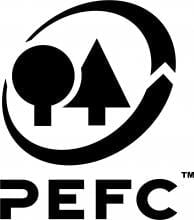Forest certification
Sustainable timber is produced ensuring that forest management and logging meet the standards of the sustainable management and use of forests more extensively than is prescribed by law. One way to verify compliance with the standards of sustainable forestry is forest certification. The purpose of voluntary forest certification verified by a third party is to produce for consumers and end-users reliable information about wood products, and to show that raw material originating from well-managed forests has been used in the product. A forest certificate is proof of the origin of the raw material.
Globally there are about 50 forest certification systems. The most widely used are PEFC (Programme for the Endorsement of Forest Certification) and FSC (Forest Stewardship Council). Finland may certify forests based on the principles of both of these, but the prevailing system is PEFC. About 95% of Finland’s forests in commercial use are certified in accordance with the Finnish PEFC system. International PEFC ensures that the national systems in different countries observe the international requirements for certification. The Finnish PEFC system was accepted for the international PEFC system in 2000.
As the consumption of wood and paper products constantly grows, pressure to utilise the forests also increases. Because of this, responsible and sustainable forest use and management are becoming increasingly important. Concern about the decline in biodiversity in forest environments was originally the main reason why the development of forest certification systems began in the early 1990s. The idea behind forest certification has thus been to promote the protection of forests and curb their disappearance.
Through forest certification, efforts are being made to ensure that forestry is practised in an ecologically, economically and socially sustainable way. For the buyers and consumers of wood products, a certificate acts as a guarantee that the wood used in the manufacture of products originates from forests managed in accordance with the principles of sustainable forestry. Through forest certification, efforts are being made to cover the entire life cycle of a wood product from forest cultivation all the way to production of the product.
In practice, a forest certificate is written proof granted by an impartial third party that the forest is managed and used sustainably in accordance with certain criteria set out in the certificate. For the forest owner, obtaining a forest certificate is voluntary. Nowadays, however, significant buyers of wood products often require the existence of a certificate.
Several dozen different forest certification systems are in use globally. The best-known and most widely used international forest certification systems are:


FSC introduced in 1993 was the first international forest certification system. The PEFC system was established in 1999 on the initiative of European forest-owners’ organisations as a competitor to FSC. Forestry and the forest industry support the PEFC system, whilst environmental and conservation organisations like WWF have put their weight behind FSC.
A dedicated national forest certificate has been developed for Finnish conditions, which is administered by Suomen Metsäsertifiointi ry: FFCS – Finnish Forest Certification System. PEFC approval was sought for FFCS in 1999 and, in 1999-2000, almost the entire Finnish forest sector was certified using the FFCS/PEFC certification system.